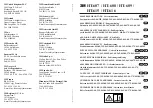
2.2.3 Router
The router is designed to increase the overall transmission distance and to bypass obstacles. Each
router has the ability to receive and transmit a maximum of 10 signals (transmitter or another router). It
is not possible to connect measuring probes to a router. For a detailed technical description, see
chapter 3.3 Router
2.2.4 Basis Station
The base station processes the data of the sensing probe and output an analogue or digital signal.
Each base station has four analogue outputs and a (optional) display. The base station of the series
E240 provides the most recent measurement readings via Modbus (ASCII, RTU, TCP), JSON and four
analogue outputs. For a detailed technical description, see chapter 3.1 Base Station.
3 FUNCTION DESCRIPTION / INSTALLATION
3.1 Base Station
With the EE242 base station a comprehensive wireless network can be build. The network can consist
out of 500 transmitters and 50 routers. Each base station can receive a maximum of 10 signals (router
or transmitter) The Ethernet interface, Modbus and Webserver allow for easy configuration of the
system as well an easy integration in existing networks.
3.1.1 Installation
The housing can be installed on DIN-rail.
To remove from the rail, both orange snap locks can be opened with the use of a screwdriver.
11
(4.3")
11
(4.3")
62
(2.4")
108
(4.3")
5
(0.2")
90
(3.5")
Pluggable antenna which can also be ordered with a remote cable
(antenna cable refer to accessories)
top hat rail mounting
3.1.2 Electrical Connections
Screw terminal assignment of series EE242:
1 2 3 4 5 6 7 8
9 10 11 12 13 14 15 16
V+
GND
GND
GND
GND
GND
NC
NC
NC
GND
B-
A+
OUT1
OUT2
OUT3
OUT4
24V AC/DC*
+
_
V/
mA
V/
mA
V/
mA
V/
mA
SELV
RS485
Modbus RTU
*) The supply circuit must be fused with ≤ 8A
Jumper to enable the
Modbus termination resistor
7
Operating manual Series EE240 Wireless sensor








































